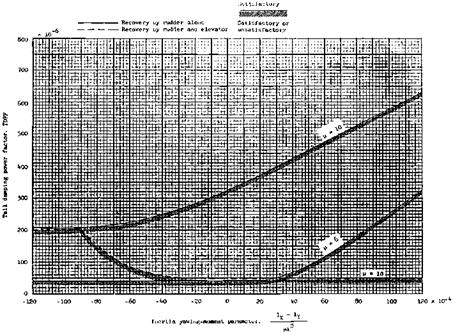Changing Spin Recovery Piloting Techniques
The 1916-era prescription for spin recovery, “thrust the control stick forward and apply rudder in the sense opposed to the rotation,” held good for many years afterwards. It was not until airplane mass distributions changed appreciably from those of early airplanes that not only design criteria, but also pilot manipulations, changed for spin recovery.
One interesting change has to do with airplanes with heavy weights along their wings. While early four-engine bombers and transports are in this category, these airplanes are not expected to be spun, even unintentionally, and indeed could fail structurally in spins. Modern light twin airplanes fall somewhat into the wing-heavy weight distribution category, and appropriate spin recovery procedures are less academic. The key result is that down-elevator
|
Figure 9.5 NACA tail design requirements for satisfactory spin recovery of personal-owner-type airplanes. The symbol і is the airplane relative density factor, with typical values of 4.0 forthe Cessna 150 and 8.6 for the Grumman/American Yankee. (From Neihouse, NACA TN 1329, 1947) |
becomes of primary importance in spin recovery, reducing greatly the need for opposite rudder.
In at least one case, this finding was ignored in the design of a popular light twin airplane (Abzug, 1977). Nominal down-elevator travel of the Rockwell Aero Commander is small, at only 10 degrees. In addition, the elevator stops are located in the cockpit area, rather than at the control surface. This allows control cable stretch at spin attitudes and airspeeds to reduce available down-deflection to an estimated 3 degrees, almost certainly insufficient for spin recovery.
An equally dramatic and significant change in pilot spin recovery techniques is required by the opposite extreme in loadings, or heavy weights along the fuselage. For this loading, representative of all modern thin-wing jet fighters, aileron with the spin becomes the primary spin recovery control, supplemented by the usual rudder against the spin. One of this book’s authors (Abzug) briefed the spin test pilot for the Douglas XF4D-1 Skyray at a time when the aileron-with recovery technique had just become known to engineers. Spin tunnel graphs and tables seemed to be getting nowhere in the pilot’s ready room at Edwards Air Force Base. Then the pilot perked up. “I see,” he said, “Ailerons with the spin will give antispin yawing moments because of adverse yaw. Adverse yaw must be large because of the low-aspect-ratio wing” [aspect ratio was just 2.0]. The matter was allowed to rest there, since as long as the controls were to be applied correctly, the misunderstanding would not matter.
Although ailerons with the spin is an accepted spin recovery technique for heavy fuselage loadings and modern power controls ensure that the controls can be applied, spin recovery problems with these airplanes are far from overcome. Heavy fuselage loadings also bring about oscillatory spins and the rather wild departure motions discussed in a later section.
Spin oscillations can be so extreme as to cause erect spins to go inverted or to confuse the pilot as to the actual direction of spin rotation.












